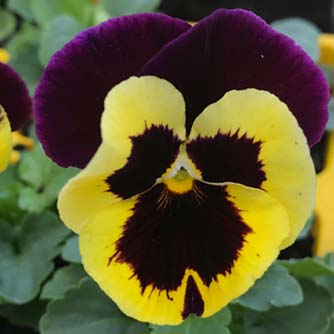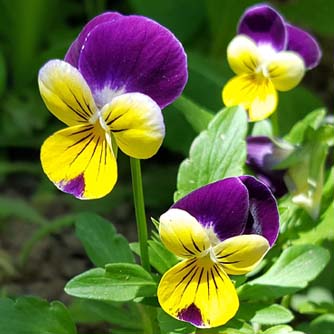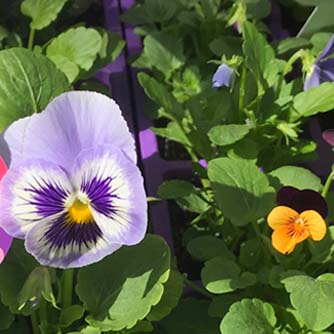Pansies and Violas
BackPansies and violas are the perfect way to liven up the garden as they are prolific bloomers and come in an endless array of vibrant colours. They look great planted as borders, en masse in a garden bed or just softly spilling over pots. Their flowers can be picked to make a cute little posy or added to salads for some extra colour (yes they’re edible!).
Both pansies and violas grow mostly as annuals in Australia and it can sometimes be confusing distinguishing between the two. Broadly speaking pansies produce large flowers in a single colour or a combination of two colours and come with a contrasting dark splotch or thin lines in the centre. Violas produce many more flowers but they are smaller and without the dark splotches. The breeding of newer varieties has blurred these lines a little but growing requirements are the same for all so don’t get too worried about their names – just enjoy the cute flowers!
How To Grow Pansies and Violas
Pansies and violas grow through the cooler months, into spring and finish once the heat of summer comes along. There are some varieties which are more heat tolerant but autumn and winter are still the best times to plant to get maximum enjoyment from them. If you live somewhere with mild summers then your pansies and violas will last longer.

Classic pansy flower with dark blotches
Choose a sunny spot with free draining soil. If the location gets a bit of late afternoon shade that’s even better as it will give extra protection when the hot weather arrives. Improve the soil before planting with some compost, manure and/or an organic pelletised fertiliser.
If starting from seed it’s best to sow into punnets first as they are fairly slow to germinate (3-4 weeks). Seeds need darkness to germinate so ensure they are covered well by soil. Keep moist the whole time and plant out when a decent size. Alternatively purchase seedlings or potted colour from the nursery and plant straightaway. Water in with OCP eco-seaweed to get them off to a great start.
Mulch around plants to protect flowers from soil splashing up, maintain moisture and keep weeds at bay. Plants will be very quick to produce buds but it’s best to pinch off the first lot so the plants put more energy into establishing themselves.
Sowing Guide for Pansies and Violas
| Growing Zone | Sowing Time |
| Cool Zones | Autumn, Spring, Summer |
| Mediterranean Zones | Autumn, Summer (late) |
| Warm & Temperate Frost Free Zones | Autumn, Summer (late) |
| Tropical & Subtropical Zones | Autumn, Summer (late) |

Popular viola known as Johny Jump Ups or Heartsease
Fertilising and Maintenance of Pansies and Violas
Water plants regularly and feed every 2 weeks with a mixture of OCP eco-seaweed and OCP eco-aminogro to encourage better flowering and strong growth.
Throughout the growing season regularly pick off the dead flower heads to encourage more flowers. If picking for a vase then cut at the base of the stem with a sharp pair of scissors or secateurs.
Many violas will self seed the following season so keep that in mind when weeding! Unfortunately pansies rarely self seed so you’ll need to sow/replant each year.
Pest and Diseases Of Pansies and Violas
Both pansies and violas will be generally trouble free if grown in free draining soil and are well fed and watered. However here are a few issues that can occur:
- Sap sucking pest like aphids, mites, whitefly and mealybugs – watch out for these guys sucking the goodness out of tender new growth. Spray with OCP eco-oil or OCP eco-neem as necessary to get them under control. It’s especially important to treat aphids as they can spread a virus which stunts and distorts growth.
- Snails and slugs – these guys love the tender leaves and petals of pansies and violas. Use OCP eco-shield pellets to protect plants.

Size comparison with a pansy on the left and a much smaller viola on the right
- Caterpillars – spray with OCP eco-neem as the first sign of holes in foliage or petals.
- Powdery mildew – this fungal disease spreads quickly and will kill plants if left untreated. If it appears in autumn or winter then spray with an organic fungicide, increase airflow around plants and minimise overhead watering to keep the foliage dry. If it appears later in spring then it indicates plants are stressed due to the increased temperature and are nearing the end of their lives. Spraying with organic fungicide will help delay things and get you a few more flowers but at some stage it'll just be better to just pull them out.
- Other fungal problems – there are other diseases which cause spots and blotches on foliage or result in stem rot and a quick plant death. They’re tricky things to control organically so prevention is the best approach. Ensure plants are grown in free draining soil and strengthened with regular doses of OCP eco-seaweed and OCP eco-aminogro to help build resilience to diseases.

To encourage more flowers remove finished flower heads (bottom left)


